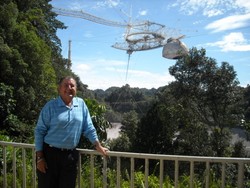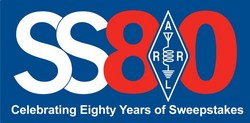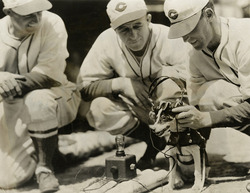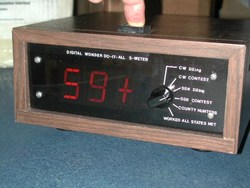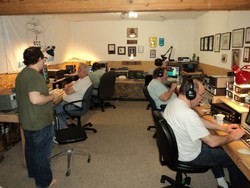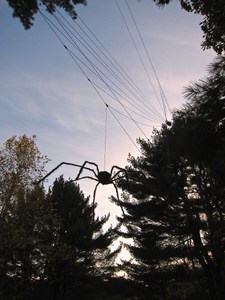 November 6, 2013 Editor: Ward Silver, NØAX | ||||||||
IN THIS ISSUE
NEW HF OPERATORS - THINGS TO DO Clearly, the hands-down winner for new HF ops in the U.S. and Canada is to jump into the Phone weekend of November Sweepstakes and have a good time. What better goal than a Clean Sweep of all 83 sections? You can download a certificate from the ARRL Sweepstakes web page and populate it with stickers for various levels of achievement - some serious, some lighthearted. If you're a fan of the digital modes, Worked All Europe will be concluding its fall season with a big RTTY contest this coming weekend. BULLETINS This is a second edition of the issue that corrects formatting errors which occured during the newsletter creation process, truncating the content and causing line-length problems. We regret the inconvenience for our readers. BUSTED QSOS Your editor failed to realize that AD6D is the U.S. call sign of Hector, XE2K. So the three people who activated K5T are AB5EB, KØAP. and AD6D/XE2K. (Thanks, Ray N6VR) CONTEST SUMMARY Complete information for all contests follows the Conversation section Nov 9-10
Nov 16-17
Just in time for this issue comes word from Angel WP3R of the Arecibo Observatory's special anniversary operation. They will be on the air commemorating the 50th anniversary of Radio Astronomy Science this coming Sunday the 10th of November from 1230 to 2000 UTC. Activity will be on 20 meter phone around 14.250 MHz. All QSL's will be a special certificate (send an SASE). The Arecibo club call sign of KP4AO will be used, transmitting from the Control Room of the telescope! Angel is the observatory's head of telescope operations and manages RFI and the RF spectrum generally. Tree N6TR notes that it appears Hi-Z Antennas will no longer have any legal issues, having settled their patent issues with DX Engineering according to this online story. This is a good thing as hams have a lot more to gain by resolving issues to mutual satisfaction and making the technology available to everyone. That's how we've moved forward for more than a century. Sweepstakes having a long and busy exchange occasionally means that errors or operating changes occasionally raise questions such as, "What happens if you change categories during the contest?" Or, "What if I mistakenly used the wrong precedence or check?" None of these will result in any penalties - the exchange is just information sent during the QSO. Once you start using an exchange or check, keep using them throughout the contest. This makes the log checking job a lot easier than if you suddenly change the information which would also confuse anybody who tunes you in after a first QSO. In the growing ranks of the remotes, this may be a record-setter. Tom K6CT lives in Solaris, Uruguay near Montevideo but logged in to one of the operating positions at K4VV in Virginia this past weekend for the ARRL CW Sweepstakes. Operating as W4YY for which he is the trustee, he made a clean sweep at a distance of 8,323 km (5,171 miles). Your editor made a QSO with W4YY and had no idea the control operator was far, far away. (Thanks, Mike WØYR)
By no means the only remotely-operated station in the Sweepstakes, if you worked VY1EI, that was really Tree N6TR at the controls while at home in Oregon. Eric, the station owner, was on-hand as well. Obviously, the remote link did not crimp their operating style with 1288 QSOs and a clean sweep claimed! Just a reminder to all of you remote ops (or those considering it) that you must identify as transmitting at the remote station site and follow all of the rules and regulations there. Dan K7SS decided to enter the CW Sweepstakes this year as a nostalgia entry, operating as K7JCA (his original call after graduating from KN7JCA Novice status). Not content with just using the call, he decided to go full bore and recreate his original 75 QSOs in the 1959 contest, each made with a J-38 hand key, paper log sheets, 75 watts, and slow high-in-the-band CW. This year those 75 QSOs just took a few hours rather than the whole 24 hours. He did "hear someone send me "QLF" but it turned out to be KA3QLF who wanted a contact!"
Web Site of the Week - Hams with a strong baseball affinity will enjoy the Baseball Hall of Fame and Museum story about Cincy, the dog that enjoyed listening to radio broadcasts. Along with Cincy, Crosley later adopted a drawing of "Bonzo" to promote the Pup line and RCA's "Nipper" was famous for "listening to his master's voice." Of course, I get that same expression when tuning in a signal on the wrong sideband. (Thanks, Eric W3DQ) WORD TO THE WISE Off time - be sure you get your off-time right in the Sweepstakes and other contests. To be on the safe side in Sweepstakes, make sure your log includes 30 consecutive "empty" minutes without a QSO. Since the log format does not "know about" seconds, this actually requires you to not log a contact for 1860 consecutive seconds (31 x 60). Note that in Sweepstakes, you may not be listening during off time and that in all contests "adjusting" the times of your logged contacts to satisfy the required duration (a.k.a. rubber-clocking) is definitely not OK and can result in disqualification. How do you cut a toroid? Very carefully, as it turns out. Take a look in this photo essay on the subject from Elektor/Circuit Cellar magazine! If you'd like to keep an eye on the proceedings at various WRTC-2014 events throughout the year, the committee has been creating photo libraries on the Photobucket service. There are excellent photos of the "falling derrick" mechanics that have piqued the interest of many and numerous photo albums, as well.
Up you go! Or at least you can climb vicariously through these videos provided by Sylvain VE2FET. The first shows him climbing an 80-foot Trylon tower to perform maintenance and the second shows how to install a couple of antennas. As always, various techniques are recommended by different climbers. Less than 9 days after the CQ World Wide SSB contest, the raw scores for more than 8000 entries are now available. These scores are based on a first pass through the log to make sure all are based on consistent scoring and multiplier lists. No checking of the contacts themselves has been performed. Please confirm that if you submitted a log, it is listed and that your category is correct. If not, email the CQ WW Committee right away. (Thanks, CQ WW Director, Randy K5ZD) The 2013 Salmon Run Results are posted on the WWDXC website. A record was set this year for receiving, checking, and processing the 319 logs received! Thanks and kudos go to Mike N7WA for putting it together. (Thanks, Jim K7WA) OPERATING TIP Here's a good reason to be hosting multi-ops, "I will have two guests, both long-time hams. I don't expect them to be contesters but I want them to see and feel and smell the fun of ham radio at its finest." (Thanks, Rich KL7RA) The fuller-than-full phone bands during the CQ World Wide SSB Contest certainly pointed out the need amateurs have in general for cleaner transmit signals. Part of the problem is the use of low-voltage 12 V power supplies for most transceivers which exacerbate intermodulation distortion and all the resulting output "stuff" which is then faithfully amplified by external linears, assuming that those are, in fact, linear and don't generate even more "stuff." But how is IMD really measured? Leigh VK5KLT suggests, "A good informative site for practical two-tone based IMD measurement on ham amplifiers is that of Larry WØQE. Other than that technique, modern SDR-based transceivers with a panadapter spectrum bandscope allows one to directly observe the occupied spectrum of an on-air signal and confirm how narrow or otherwise the transmit frequency occupancy is and deduce the signal's IMD characteristics." Jeff ACØC points out that a Softrock receiver and free PowerSDR software will do the job nicely for under $20. Jim N7CXI also generated a 30-second two-tone test WAV file and posted it online to use during testing. Numerous sound-card spectrum analysis software is available to help with testing if you want to go that route. So there's really no serious barrier to performing these tests. It's good to see the CQ World Wide Contest Committee starting to pay attention to some of the signals on the bands that are far wider than they need to be and are considered unsportsmanlike conduct.
Would you like to add a little copper or nickel plating to your project or components? If so, that pair of Instructables articles should be quite helpful. And for those of you who, like the editor, prefer to have their tools stored consistently for easy (and quick) access, another article describes building a handy stand for your drill bits and can be adapted to all sorts of uses. It may not be common knowledge that running your "12-volt" radio at 12 volts is really too low for it! If you look at the specification for nearly all commercial radios, they really are designed to be operated at the typical voltage of an automotive power system while the engine is running - 13.8 volts. The lower voltage often results in poor transmitted signals with chirp, clicks, and distortion. Note, too, that a loose power supply connection can also cause problems as voltage at the radio input drops under load. Steve N2IC notes that it only take 0.06 ohms of "extra" resistance to cause 1 volt of drop at 17 amps. Make sure your power supply connections are tight before the contest and be a good neighbor.
Greg ZL3IX was trying to measure his Beverage antenna system resistance with a DMM and found that "along with RF pickup from nearby BC stations...one other effect that fools sensitive DMM's on their resistance scale, is the electrochemical voltage...developed between the ground rods used for Beverage antennas. I also experienced gross inconsistencies when trying to check for breaks using DC resistance checks." His solution? "For the past few years I have been using a little op-amp oscillator, running at about 100 Hz. I put 100 ohms in series with the op-amp output and apply the signal across the terminated Bev(erage). I then measure the AC mV across the Bev(erage) and across the 100-ohm resistor, and calculate the AC resistance from that. This method has proved to be ultra reliable for detecting breaks in the wire." Modulators versus multipliers, what's the difference? This Analog Devices article explains that while the math looks about the same, practical considerations win the day. If you are trying to corral unruly cables, try enclosing them in "Split Loom" flexible tubing such as is used in automobile engine compartments. The material is tough, stands up to the weather and sunlight, yet is easy to work with. (Thanks, Ivan WK1W) Technical Web Site of the Week - If you are trying to figure out how to translate lightning-induced transients into the pulse ratings of individual components, try this lightning transient calculator provided by EDN magazine. I'm not sure I want to be around when you validate it, though! How Good Was It? After back-to-back weekends of what has been widely characterized as extraordinary conditions, your editor wanted to know, "So how good was it, really?" Were the conditions really that good or were we just so delighted to have anything approaching decent propagation that we fell into a bout of irrational exuberance?
This was a good reason to go use Bruce WA7BNM's revamped score reporting website, 3830scores.com. For those of you who haven't checked it out, now would be a great time! It's a major upgrade to the older 3830 score reporting system. You can still report your claimed score but now Bruce has created an online summary system that supersedes the old emailed summaries. (Those are still being emailed out to the various reflectors, such as cq-contest.) Back to the question, though. How good was it? Well, Tom W2SC reports a claimed QSO total of more than 10,000 QSOs as 8P5A in the CQ WW SSB contest. The last time that was done, N5TJ was tearing up the record book from EA8 and N6KT was operating from HC8 during Cycle 22. You don't make 10 kQSOs without excellent, sustained, worldwide propagation on several bands. Checking things here in the 'States, let's look at the top dozen reported Single-Op, All-Band, High Power scores in - arguably - the most competitive category in radiosport: Call - Score N2IC - 7,762,982 That list goes: New Mexico, Connecticut, Indiana, Arkansas, New Hampshire, Pennsylvania, Maryland, Texas (twice), New York, and California (twice). When was the last time you saw a fifth-district call sign atop the SOAB-HP standings? You will be scratching your head for a long time because the answer is "Never!" And there are three 5-land calls along with the others, spread out from sea to shining sea. Around the world, the SOAB-HP category Top Ten includes entries from all of the continents: Call - Score CN2R (W7EJ) - 18,856,075 Africa, North America, Europe, North America, Oceania, South America, Africa, Europe, North America, and Asia - wow! Truly a worldwide contest! OK, how about the first weekend of the ARRL Sweepstakes? The good conditions just kept on giving. One of the best indicators is how available were contacts with the far northern and almost mythical in some years Yukon-Northwest Territories. As noted previously, Tree N6TR fired up VY1EI over a remote link and was actually leading the contest for three hours! Tree and Eric's final total was 1288 QSOs and a sweep which is a new Canadian multiop record made with a tribander and wires. This is also the highest score ever from VE8/VY1 where a log with 1000 QSOs is basically unheard of. I have not heard any comments asking (or complaining) "where was Yukon?" this time around. The big question is whether ol' Sol will continue to beam a beneficial bounty of UV Earth-ward without any solar nasties like flares and CMEs that light up the night sky over places like Whitehorse and Fairbanks and Murmansk and Arcala, shutting down the all-important polar paths and causing contesters to cry in their cups. The 27-day rotation is favorable, the hiccups have been small, and we all have our fingers crossed. Hey, CQ WW CW doesn't even fall on the U.S. Thanksgiving holiday this year! Let's hope for continued good cheer on the HF bands so that when we are retelling the tale to younger hams years from now we can start with, "How good was it? Well, let me tell you..." November 6 through November 19 An expanded, downloadable version of QST's Contest Corral in PDF format is available. Check the sponsor's Web site for information on operating time restrictions and other instructions. HF CONTESTS ARRL November Sweepstakes--Phone, from Nov 16, 2100Z to Nov 18, 0300Z. Bands (MHz): 1.8-28. Exchange: Serial, category, call, check, ARRL/RAC sec. Logs due: Dec 4. Rules Worked All Europe DX Contest--Digital, from Nov 9, 0000Z to Nov 10, 2400Z. Bands (MHz): 3.5-28. Exchange: RST and serial (see web for QTC rules). Logs due: 2 weeks. Rules 10-10 Fall Digital QSO Party--Digital, from Nov 9, 0001Z to Nov 10, 2359Z. Bands (MHz): 28. Exchange: Call, name, 10-10 number, S/P/C. Logs due: Nov 25. Rules Japan International DX Contest--Phone, from Nov 9, 0700Z to Nov 10, 1300Z. Bands (MHz): 3.5-28. Exchange: RST and JA prefecture or CQ Zone. Logs due: 30 days. Rules OK-OM DX Contest--CW, from Nov 9, 1200Z to Nov 10, 1200Z. Bands (MHz): 1.8-28. Exchange: RST and serial or OK/OM district. Logs due: Dec 1. Rules Straight Key Weekend Sprintathon--CW, from Nov 9, 1200Z to Nov 10, 2359Z. Bands (MHz): 3.5-28. Monthly beginning on the second Saturday local time. Exchange: RST, S/P/C, name, SKCC nr or "none". Logs due: 5 days. Rules Kentucky QSO Party--Phone,CW,Digital, from Nov 9, 1400Z to Nov 10, 0200Z. Bands (MHz): 1.8-28, 50, CW--1.815, 3.550, 7.050, 14.050, 21.050, 28.050, 50.090; SSB--1.855, 3.820, 7.240, 14.280, 21.390, 28.390, 50.190 MHz. Exchange: RST and KY county or S/P/C. Logs due: Dec 31. Rules CQ WE (Western Electric)--Phone,CW,Digital, from Nov 9, 1900Z to Nov 11, 0500Z. Bands (MHz): 1.8-28, 50-440. Exchange: Call, name, Bell QTH, yrs of service. Logs due: Dec 1. Rules CWops Monthly Mini-CWT Test--CW, from Nov 13, 1300Z - See website. Multiple time periods. Bands (MHz): 1.8-28. Twice monthly on 2nd and 4th Wed, 18 to 28 kHz above band edge. Exchange: Name and member number or S/P/C. Logs due: 2 days. Rules NAQCC Monthly QRP Sprint--CW, from Nov 14, 0130Z to Nov 14, 0330Z. Bands (MHz): 3.5-14. Monthly on 2nd Tuesday or 3rd Wednesday local time (alternating). Exchange: RST, S/P/C, and NAQCC mbr nr or power. Logs due: 4 days. Rules LZ DX Contest--Phone,CW, from Nov 16, 1200Z to Nov 17, 1200Z. Bands (MHz): 3.5-28. Exchange: RST and ITU Zone or LZ district. Logs due: 30 days. Rules Feld-Hell Turkey Shoot Sprint--Digital, from Nov 16, 1600Z to Nov 16, 1800Z. Bands (MHz): 3.5-28. Monthly on 3rd Saturday. Exchange: RST, S/P/C, Feld-Hell member nr. Logs due: 5 days. Rules All Austria 160 Meter Contest--CW, from Nov 16, 1600Z to Nov 17, 0700Z. Bands (MHz): 1.8. Exchange: RST, serial, OE district. Logs due: Dec 31. Rules Collegiate ARC Championship--Phone, from Nov 16, 2100Z to Nov 18, 0300Z. Bands (MHz): 1.8-28. Exchange: See ARRL Sweepstakes. Logs due: Dec 4. Rules RSGB Second 1.8 MHz Contest--CW, from Nov 16, 2100Z to Nov 17, 0100Z. Bands (MHz): 1.8. Exchange: RST, serial, UK district. Logs due: 16 days. Rules Homebrew and Oldtime Contest--CW, from Nov 17, 1300Z to Nov 17, 1700Z. Bands (MHz): 3.5-7. Exchange: RST, serial, and category. Logs due: Dec 18. Rules Run For the Bacon--CW, from Nov 18, 0200Z to Nov 18, 0400Z. Bands (MHz): 1.8-28. Monthly on 3rd Sunday night (local). Exchange: RST, S/P/C, Flying Pig nr or power. Rules VHF+ CONTESTS ARRL EME Contest--Phone,CW,Digital, from Nov 16, 0000Z to Nov 17, 2359Z. Bands (MHz): 50-1296. Exchange: Call signs, sig rpt, acknowledgement. Logs due: Jan 1. Rules Kentucky QSO Party--Phone,CW,Digital, from Nov 9, 1400Z to Nov 10, 0200Z. Bands (MHz): 1.8-28, 50, CW--1.815, 3.550, 7.050, 14.050, 21.050, 28.050, 50.090; SSB--1.855, 3.820, 7.240, 14.280, 21.390, 28.390, 50.190 MHz. Exchange: RST and KY county or S/P/C. Logs due: Dec 31. Rules CQ WE (Western Electric)--Phone,CW,Digital, from Nov 9, 1900Z to Nov 11, 0500Z. Bands (MHz): 1.8-28, 50-440. Exchange: Call, name, Bell QTH, yrs of service. Logs due: Dec 1. Rules LOG DUE DATES November 6 through November 19
ARRL Information Click here to advertise in this newsletter, space subject to availability. Your One-Stop Resource for Amateur Radio News and Information ARRL membership includes QST, Amateur Radio's most popular and informative journal, delivered to your mailbox each month. Subscribe to NCJ - the National Contest Journal. Published bimonthly, features articles by top contesters, letters, hints, statistics, scores, NA Sprint and QSO Parties. Subscribe to QEX - A Forum for Communications Experimenters. Published bimonthly, features technical articles, construction projects, columns and other items of interest to radio amateurs and communications professionals. Free of charge to ARRL members: Subscribe to The ARRL Letter (weekly digest of news and information), the ARES E-Letter (monthly public service and emergency communications news), Division and Section news -- and much more! ARRL offers a wide array of products to enhance your enjoyment of Amateur Radio. Visit the site often for new publications, specials and sales. Donate to the fund of your choice -- support programs not funded by member dues! Reprint permission can be obtained by sending email to permission@arrl.org with a description of the material and the reprint publication. ACKNOWLEDGEMENTS ARRL Contest Update wishes to acknowledge information from WA7BNM's Contest Calendar and SM3CER's Contest Calendar. | ||||||||
